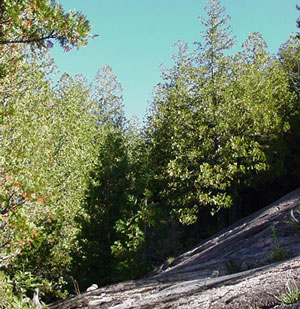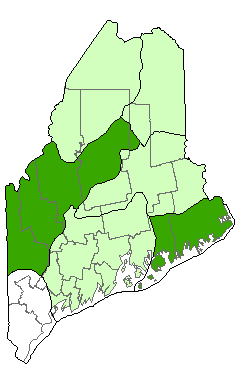DACF Home → Bureaus & Programs → Maine Natural Areas Program → Communities, Plants, and Animals → Natural Community Fact Sheets → White Cedar Woodland
Printer Friendly Fact Sheet - 870 MB pdf (Get a free copy of Adobe Acrobat Reader)
White Cedar Woodland
Scientific Name: White Cedar Woodland; State Rank: S2

- Community Description
- Soil and Site Characteristics
- Diagnostics
- Similar Types
- Conservation, Wildlife and Management Considerations
- Distribution
- Characteristic Plants
- Associated Rare Plants
- Associated Rare Animals
- Examples on Conservation Lands You Can Visit
Community Description: This type is a partial canopy upland woodland (30-85% closure) in which northern white cedar is the dominant tree. Cedar may make up almost the entire canopy, or it may be mixed with lesser amounts of white pine, balsam fir, or other species. Lower layers all tend to be sparse (<25% cover each), with only scattered plants. Species composition varies according to the site’s moisture regime. Where seeps maintain somewhat mesic conditions, one finds plants such as bush-honeysuckle and meadowsweet, while under more xeric conditions mountain holly and black huckleberry are representative. The sparse bryoid layer contains mostly bryophytes rather than lichens. Back to top.
Soil and Site Characteristics: Sites occur on rocky hillslopes with 10-70% slope. The substrate is bedrock, talus, or coarse glacial till, with a thin (<15 cm) layer of sandy soil or poorly decomposed organic duff developing in pockets or over portions of the rock. Sites with seepage moisture tend to have deeper soils, but soil depth is <30 cm. Known sites are either on acidic substrates near the coast or on somewhat calcareous rocks inland. Back to top.
Diagnostics: This type is a partial canopy woodland dominated by northern white cedar (>30% cover); heath shrubs are not prominent in the herb layer (<20% cover). Back to top.
Similar Types: Some Spruce - Pine Woodlands may be co-dominated by northern white cedar, but they also have a heath shrub layer. Other northern white cedar dominated community types are wetlands or seepage forests on flatter, deeper, mineral or organic soils. Back to top.
Conservation, Wildlife and Management Considerations: Little is known about the distribution and landscape setting of these woodlands. Documented at sites either on the Downeast Coast (e.g., Acadia National Park) or at higher elevations inland. Sites are generally inoperable from a forestry standpoint, and recreational use may be the biggest conservation concern. There is evidence of fire at some sites, but the role of fire in creating or perpetuating this type is not clear. Examples of this community type that occur on bedrock or talus may provide cool, moist crevices that offer suitable habitat for the long-tailed shrew. Back to top.
Distribution: Laurentian Mixed Forest and New England - Adirondack Provinces, known from east-coastal and north-central Maine; distribution elsewhere not well documented. Landscape Pattern: Small Patch. Back to top.


Characteristic Plants: These plants are frequently found in this community type. Those with an asterisk are often diagnostic of this community.
- Canopy
- Balsam fir
- Northern white cedar*
- Paper birch
- Sapling/shrub
- Balsam fir*
- Northern white cedar
- Dwarf Shrub
- Lowbush blueberry
- Herb
- Starflower
- Bryoid
- Dicranum moss
There are no documented examples of rare animals associated with this natural community.
Examples on Conservation Lands You Can Visit
| Example | County |
|---|---|
| Bubble Pond, Acadia National Park | Hancock Co. |
| Pemetic Mountain, Acadia National Park | Hancock Co. |